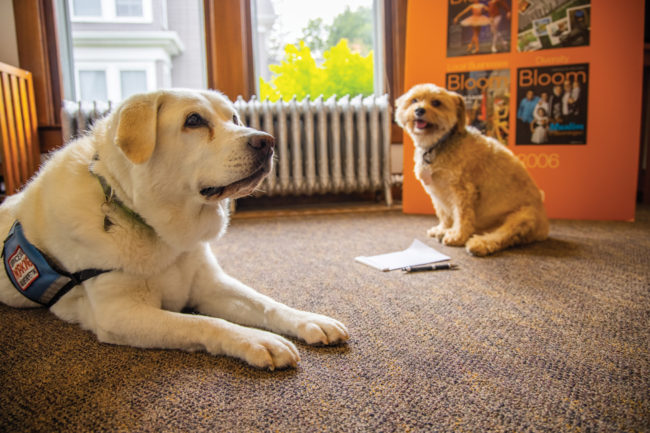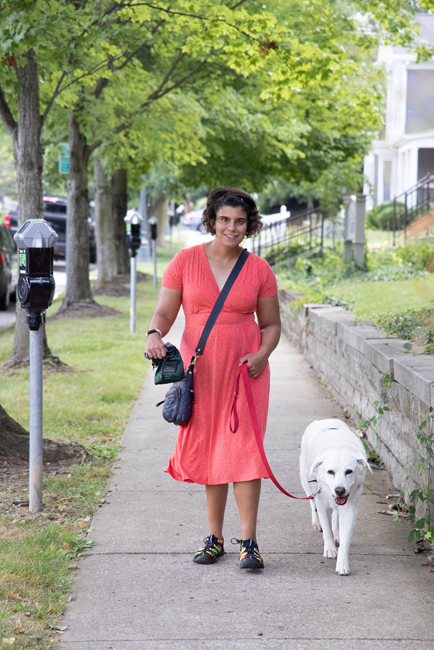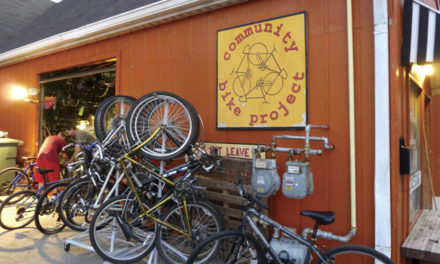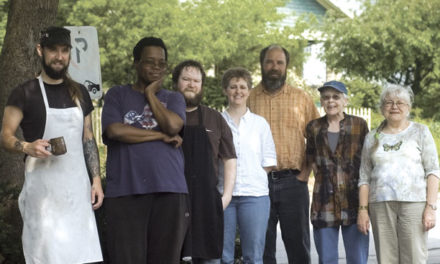
Lucy, a white Lab service dog, has been probably the most recognizable canine in town as the constant companion of Adria Nassim, whose popular column in The Herald-Times deals with autism and disability-related issues. With the help of Lucy, Nassim has overcome her own challenges related to autism and cerebral palsy. Lucy has just retired after 11 1/2 years.
Yogurt Abrams, Bloom’s canine correspondent, managed to sniff out this exclusive interview.
YOGURT: I’ve wondered about this for a long time: As a service dog, you get to go in restaurants. What’s it like inside?
LUCY: Oh, the smells … goodness! Restaurants have a little bit of everything in the air … steak, vegetables, seafood, cheese, whatever you want! The key for a service dog like me is, you have to demonstrate self-control. Gosh, Adria and I have been in restaurants and a shrimp or a few french fries might drop to the floor and I have to ignore them. Do you understand how much self-control that takes?
YOGURT: Because you are a service dog, do you have a lot of rules that you have to follow? Like what?
LUCY: Like no interaction with other dogs while I’m wearing the vest. (Sorry, you are a handsome dog, but I don’t wear the vest just to look cute.)
YOGURT: How do you assist Adria? And what kinds of other tasks can service dogs do?
LUCY: I help Adria with balance and stability on stairs and uneven surfaces due to cerebral palsy. When Adria was younger, I would also often scent track the way home on cue due to spatial orientation difficulties caused by autism and a severe learning disability. However, now she has become much more familiar with Bloomington and generally knows how to safely find the way home.
Service dogs can also be trained to assist with all sorts of tasks like picking up and retrieving items for people who use wheelchairs, alerting or responding to a seizure, or detecting changes in blood sugar levels for people with diabetes.

YOGURT: Do you know how to shake hands? I do.
LUCY: Yes.
YOGURT: Know any other tricks?
LUCY: I give high-fives and fist bumps. I can find the tennis ball on cue when hidden and bring it back, “speak” on command, play hide- and-seek, and spin in a circle. Some of these tricks Adria taught me as a way of helping kids in the community get to know me and become comfortable around a service dog.
YOGURT: What do you have to do to get a uniform like yours?
LUCY: Service dogs or guide dogs, which are trained to assist individuals with challenges, are trained by professionally licensed and accredited service dog training programs or licensed professional dog trainers.
The training process, when done well, begins when puppies are 3 to 6 weeks old and lasts until they are graduated and partnered at age 2 to 2 1/2 years old.
During training, I was exposed to multitudes of different environments and situations such as stores, restaurants, medical offices, public transportation, other dogs, children, and excessive noise. The trainers who worked with me were also careful to monitor my temperament and disposition for signs such as aggression, possessiveness, a high level of shyness, or fear of new situations or people, high distractibility, and so forth. Training sessions were two to three times per day for 10 minutes at a time.
YOGURT: What’s your favorite food?
LUCY: The only food I’m allowed is kibble and the occasional dog biscuit. Part of service dog training involves
not giving the dog people food as it can encourage bad habits such as begging and potentially eating off the floor or ground in public places.
YOGURT: How do you feel about squirrels and rabbits?
LUCY: Every squirrel and rabbit I have ever met is named “Leave It,” according to Adria. I always thought she was the creative type, but I guess she has better things to do than name all the squirrels and rabbits in this town. Anyway, I just let them go about their day.
YOGURT: How’d you get the name Lucy?
LUCY: Lucy comes from the Beatles’ 1967 hit “Lucy in the Sky with Diamonds” from the Sgt. Pepper’s Lonely Hearts Club Band album. Since her early teens, Adria has been a huge fan of the Beatles. We even took “The History of the Beatles” class together at Indiana University when I was about a year and a half old. I’m very proud to say I did very well and sat beside her chair listening quietly the whole semester (except for the occasional snore when I would fall asleep.)
YOGURT: How would you rate Adria as a partner on a scale of one kibble to 10 kibbles?
LUCY: Well, since you asked, Adria and I have been partnered together the last 11 years. She has a very strong work ethic, which I love because she is not afraid to continue to work with me and with herself until she sees noticeable improvement or a specific result. She is very patient, which is great because us dogs are not trained in a day or even a few weeks, but she can also be firm and demonstrate good leadership when necessary. She’s also really fun and loves to hide the ball on me or pet me and hand me my favorite chew toy at the end of the day. Life with Adria is pawsitively awesome and I love it! Definitely 11 kibbles!












